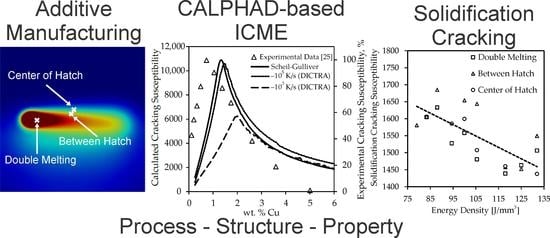Integration of Processing and Microstructure Models for Non-Equilibrium Solidification in Additive Manufacturing
Abstract
:1. Introduction
2. Materials and Methods
3. Results
3.1. Modeling Non-Equilibrium Solidification of Al-Cu Alloys
3.2. Predicting Thermal History during the Laser Powder Bed Fusion Process
3.3. Solidification of SS316L during Additive Manufacturing
4. Discussion
5. Conclusions
- The TC-Python application programing interface is used to couple a thermal model for the LPBF process with a DICTRA solidification model to simulate the process-microstructure relationship between processing variables and non-equilibrium solidification in additively manufactured materials. Automation of the CALPHAD-based ICME framework with the TC-Python application programing interface enables DICTRA calculations to be used as a high-throughput computational materials design tool. Improvement of numerical algorithms within DICTRA is necessary to enhance the computational efficiency of diffusion simulations.
- A linear relationship between SCS and energy density in SS316L manufactured by LPBF is predicted using a CALPHAD-based ICME framework. A location-dependent relationship with SCS in SS316L is not found.
- The ICME modeling framework developed in this work demonstrates the importance of integrating mechanical and materials models for design simulations in additive manufacturing. The developed modeling framework can be used to guide alloy design and process optimization for additive manufacturing. This framework can also be applied to other processing techniques provided a suitable thermal model is available. Since the present ICME model is based on thermodynamics and diffusion model-predictions, sustainable improvement of the CALPAHD database fidelity is critical to sustaining model accuracy.
Author Contributions
Funding
Institutional Review Board Statement
Informed Consent Statement
Acknowledgments
Conflicts of Interest
References
- Kou, S. Solidification and liquation cracking issues in welding. JOM 2003, 55, 37–42. [Google Scholar] [CrossRef]
- Böllinghaus, T.; Herold, H.; Cross, C.E.; Lippold, J.C. Hot cracking phenomena in welds II. In Hot Cracking Phenomena in Welds II; Springer: New York, NY, USA, 2008; pp. 1–18. [Google Scholar] [CrossRef]
- Eskin, D.; Du, Q.; Ruvalcaba, D.; Katgerman, L. Experimental study of structure formation in binary Al–Cu alloys at different cooling rates. Mater. Sci. Eng. A 2005, 405, 1–10. [Google Scholar] [CrossRef]
- Xiong, W.; Olson, G.B. Cybermaterials: Materials by design and accelerated insertion of materials. NPJ Comput. Mater. 2016, 2. [Google Scholar] [CrossRef] [Green Version]
- Xiong, W.; Olson, G.B. Integrated computational materials design for high-performance alloys. MRS Bull. 2015, 40, 1035–1044. [Google Scholar] [CrossRef] [Green Version]
- Bobbio, L.D.; Bocklund, B.; Reichardt, A.; Otis, R.; Borgonia, J.P.; Dillon, R.P.; Shapiro, A.A.; McEnerney, B.W.; Hosemann, P.; Liu, Z.-K.; et al. Analysis of formation and growth of the σ phase in additively manufactured functionally graded materials. J. Alloys Compd. 2020, 814. [Google Scholar] [CrossRef]
- Wang, X.; Sridar, S.; Xiong, W. Thermodynamic Investigation of New High-Strength Low-Alloy Steels with Heusler Phase Strengthening for Welding and Additive Manufacturing: High-Throughput CALPHAD Calculations and Key Experiments for Database Verification. J. Phase Equilibria Diffus. 2020, 41, 804–818. [Google Scholar] [CrossRef]
- Hyer, H.; Zhou, L.; Mehta, A.; Sohn, Y. Effects of Alloy Composition and Solid-State Diffusion Kinetics on Powder Bed Fusion Cracking Susceptibility. J. Phase Equilibria Diffus. 2020. [Google Scholar] [CrossRef]
- Sames, W.J.; List, F.A.; Pannala, S.; Dehoff, R.R.; Babu, S.S. The metallurgy and processing science of metal additive manufacturing. Int. Mater. Rev. 2016, 61, 315–360. [Google Scholar] [CrossRef]
- Smith, J.; Xiong, W.; Yan, W.; Lin, S.; Cheng, P.; Kafka, O.L.; Wagner, G.J.; Cao, J.; Liu, W.K. Linking process, structure, property, and performance for metal-based additive manufacturing: Computational approaches with experimental support. Comput. Mech. 2016, 57, 583–610. [Google Scholar] [CrossRef]
- Chen, Q.; Sundman, B. Computation of Partial Equilibrium Solidification with Complete Interstitial and Negligible Substitutional Solute Back Diffusion. Mater. Trans. 2002, 43, 551–559. [Google Scholar] [CrossRef] [Green Version]
- Yan, X.; Lin, J.C. Prediction of hot tearing tendency for multicomponent aluminum alloys. Metall. Mater. Trans. B 2006, 37, 913–918. [Google Scholar] [CrossRef]
- Kou, S. A criterion for cracking during solidification. Acta Mater. 2015, 88, 366–374. [Google Scholar] [CrossRef]
- Liu, J.; Kou, S. Crack susceptibility of binary aluminum alloys during solidification. Acta Mater. 2016, 110, 84–94. [Google Scholar] [CrossRef] [Green Version]
- Borgenstam, A.; Höglund, L.; Ågren, J.; Engström, A. DICTRA, a tool for simulation of diffusional transformations in alloys. J. Phase Equilibria 2000, 21, 269–280. [Google Scholar] [CrossRef]
- Lippard, H.E.; Campbell, C.E.; Dravid, V.P.; Olson, G.B.; Björklind, T.; Borggren, U.; Kellgren, P. Microsegregation behavior during solidification and homogenization of AerMet100 steel. Metall. Mater. Trans. B 1998, 29, 205–210. [Google Scholar] [CrossRef]
- Zhang, L.; Du, Y.; Steinbach, I.; Chen, Q.; Huang, B. Diffusivities of an Al–Fe–Ni melt and their effects on the microstructure during solidification. Acta Mater. 2010, 58, 3664–3675. [Google Scholar] [CrossRef]
- Valiente Bermejo, M.A.; Wessman, S. Computational thermodynamics in ferrite content prediction of austenitic stainless steel weldments. Weld. World 2018, 63, 627–635. [Google Scholar] [CrossRef] [Green Version]
- Keller, T.; Lindwall, G.; Ghosh, S.; Ma, L.; Lane, B.M.; Zhang, F.; Kattner, U.R.; Lass, E.A.; Heigel, J.C.; Idell, Y.; et al. Application of Finite Element, Phase-field, and CALPHAD-based Methods to Additive Manufacturing of Ni-based Superalloys. Acta Mater. 2017, 139, 244–253. [Google Scholar] [CrossRef]
- Lindwall, G.; Campbell, C.E.; Lass, E.A.; Zhang, F.; Stoudt, M.R.; Allen, A.J.; Levine, L.E. Simulation of TTT Curves for Additively Manufactured Inconel 625. Metall. Mater. Trans. A 2018, 50, 457–467. [Google Scholar] [CrossRef] [Green Version]
- Wolfer, A.J.; Aires, J.; Wheeler, K.; Delplanque, J.-P.; Rubenchik, A.; Anderson, A.; Khairallah, S. Fast solution strategy for transient heat conduction for arbitrary scan paths in additive manufacturing. Addit. Manuf. 2019, 30. [Google Scholar] [CrossRef]
- Gilat, A.; Subramaniam, V. Numerical Methods for Engineers and Scientists; Wiley: Hoboken, NJ, USA, 2013; Volume 3, pp. 319–320. [Google Scholar]
- Wolfer, A.J. Physics-based Surrogate Modeling of Laser Powder Bed Fusion Additive Manufacturing. Ph.D. Thesis, University of California Davis, Davis, CA, USA, 2021. [Google Scholar]
- Campbell, J.; Clyne, T.W. Hot Tearing in Al-Cu Alloys. Cast Met. 1990, 3, 224–226. [Google Scholar] [CrossRef]
- Novikov, I.I. Goryahelomkost Tsvetnykh Metallov i Splavov (Hot-Shortness of Nonferrous Metals and Alloys); Nauka: Moscow, Russia, 1966; pp. 1–299. [Google Scholar]
- Warrington, D.; McCartney, D.G. Development of a New Hot-cracking Test for Aluminium Alloys. Cast Met. 1989, 2, 134–143. [Google Scholar] [CrossRef]
- Pumphrey, W. The Aluminum Development Association Report No. 27; Aluminum Development Association: London, UK, 1955. [Google Scholar]
- Khairallah, S.A.; Anderson, A. Mesoscopic simulation model of selective laser melting of stainless steel powder. J. Mater. Process. Technol. 2014, 214, 2627–2636. [Google Scholar] [CrossRef]
- Yan, F.; Xiong, W.; Faierson, E.; Olson, G.B. Characterization of nano-scale oxides in austenitic stainless steel processed by powder bed fusion. Scr. Mater. 2018, 155, 104–108. [Google Scholar] [CrossRef]
- Khairallah, S.A.; Anderson, A.T.; Rubenchik, A.; King, W.E. Laser powder-bed fusion additive manufacturing: Physics of complex melt flow and formation mechanisms of pores, spatter, and denudation zones. Acta Mater. 2016, 108, 36–45. [Google Scholar] [CrossRef] [Green Version]
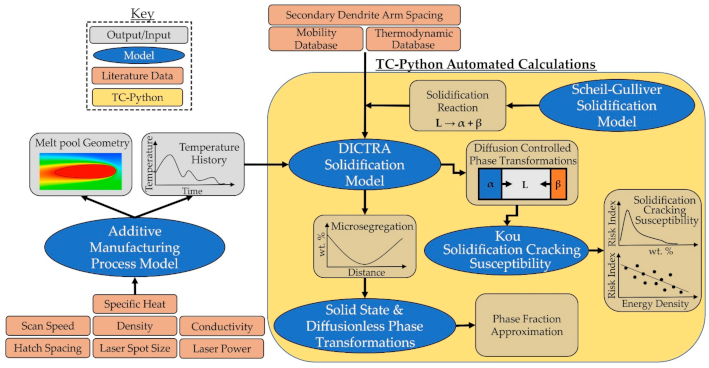

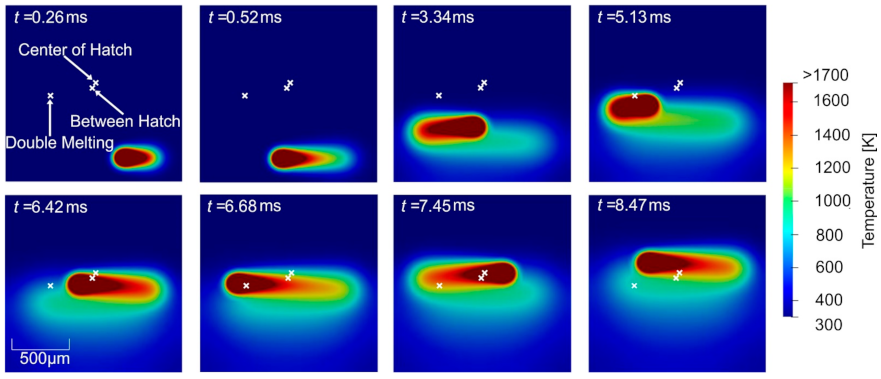
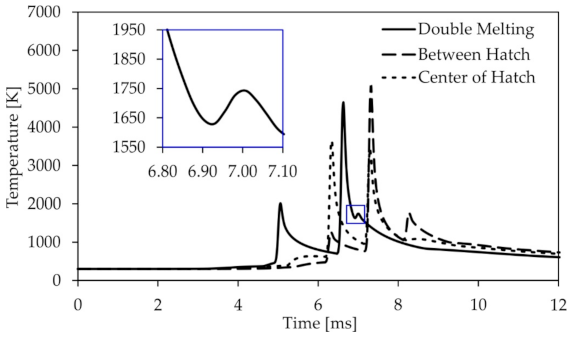
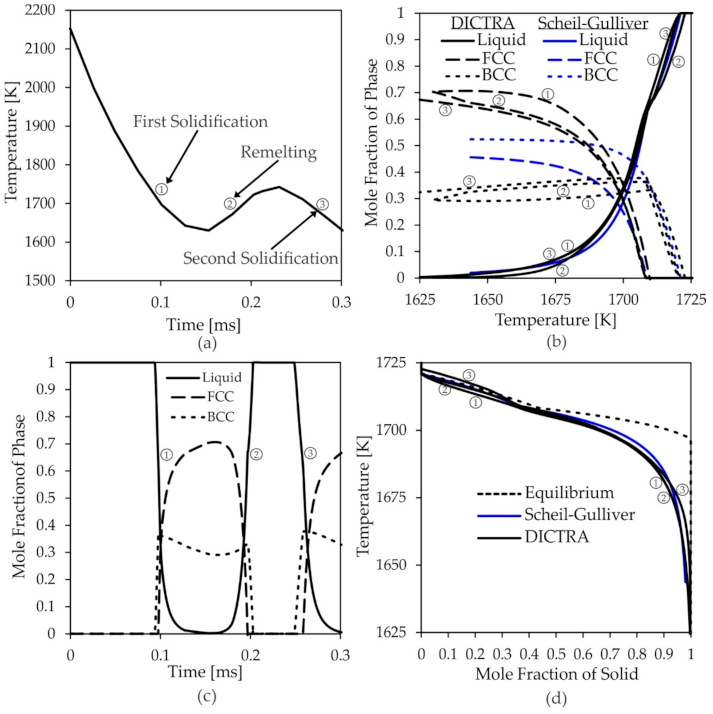
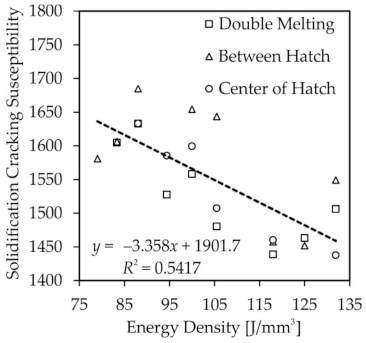
Publisher’s Note: MDPI stays neutral with regard to jurisdictional claims in published maps and institutional affiliations. |
© 2021 by the authors. Licensee MDPI, Basel, Switzerland. This article is an open access article distributed under the terms and conditions of the Creative Commons Attribution (CC BY) license (http://creativecommons.org/licenses/by/4.0/).
Share and Cite
Sargent, N.; Jones, M.; Otis, R.; Shapiro, A.A.; Delplanque, J.-P.; Xiong, W. Integration of Processing and Microstructure Models for Non-Equilibrium Solidification in Additive Manufacturing. Metals 2021, 11, 570. https://doi.org/10.3390/met11040570
Sargent N, Jones M, Otis R, Shapiro AA, Delplanque J-P, Xiong W. Integration of Processing and Microstructure Models for Non-Equilibrium Solidification in Additive Manufacturing. Metals. 2021; 11(4):570. https://doi.org/10.3390/met11040570
Chicago/Turabian StyleSargent, Noah, Mason Jones, Richard Otis, Andrew A. Shapiro, Jean-Pierre Delplanque, and Wei Xiong. 2021. "Integration of Processing and Microstructure Models for Non-Equilibrium Solidification in Additive Manufacturing" Metals 11, no. 4: 570. https://doi.org/10.3390/met11040570





